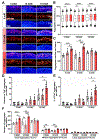Copper enhances aggregational toxicity of mutant huntingtin in a Drosophila model of Huntington's Disease
- PMID: 38660915
- PMCID: PMC11046041
- DOI: 10.1016/j.bbadis.2023.166928
Copper enhances aggregational toxicity of mutant huntingtin in a Drosophila model of Huntington's Disease
Abstract
Huntington's disease (HD) is a progressive neurodegenerative disorder with clinical presentations of moderate to severe cognitive, motor, and psychiatric disturbances. HD is caused by the trinucleotide repeat expansion of CAG of the huntingtin (HTT) gene. The mutant HTT protein containing pathological polyglutamine (polyQ) extension is prone to misfolding and aggregation in the brain. It has previously been observed that copper and iron concentrations are increased in the striata of post-mortem human HD brains. Although it has been shown that the accumulation of mutant HTT protein can interact with copper, the underlying HD progressive phenotypes due to copper overload remains elusive. Here, in a Drosophila model of HD, we showed that copper induces dose-dependent aggregational toxicity and enhancement of Htt-induced neurodegeneration. Specifically, we found that copper increases mutant Htt aggregation, enhances the accumulation of Thioflavin S positive β-amyloid structures within Htt aggregates, and consequently alters autophagy in the brain. Administration of copper chelator D-penicillamine (DPA) through feeding significantly decreases β-amyloid aggregates in the HD pathological model. These findings reveal a direct role of copper in potentiating mutant Htt protein-induced aggregational toxicity, and further indicate the potential impact of environmental copper exposure in the disease onset and progression of HD.
Keywords: Aggregates; Chelation; Copper; Huntingtin; Huntington's disease.
Copyright © 2023 Elsevier B.V. All rights reserved.
Conflict of interest statement
Declaration of competing interest Authors declare that they have no competing interests.
Figures






References
-
- Bates G, Huntingtin aggregation and toxicity in Huntington’s disease. The Lancet, 2003. 361(9369): p. 1642–1644. - PubMed
Publication types
MeSH terms
Substances
Grants and funding
LinkOut - more resources
Full Text Sources
Medical
Molecular Biology Databases

